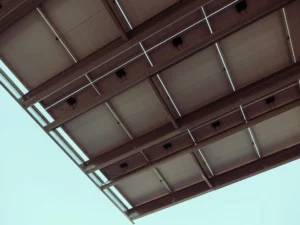If you’ve ever seen a construction crew pouring concrete with long hoses or massive machines stretching across a site, you’ve already seen concrete pumping in action.
But what is concrete pumping, exactly? And why is it such a big deal in modern construction?
Whether you’re building a patio, installing a pickleball court, or pouring a foundation, concrete pumping makes big jobs faster, cleaner, and more precise. In this blog, we’ll walk through how concrete pumps work, what they’re used for, and whether it’s something you can (or should) do yourself.
Let’s break it down.
What Is Concrete Pumping?
Concrete pumping is the process of moving liquid concrete from a mixing truck to the exact place where it’s needed—using a mechanical pump system instead of wheelbarrows or buckets.
Instead of manually hauling heavy, wet concrete across a job site, a concrete pump uses pressure to push the mix through hoses or pipes. The pump can reach across large distances, up multiple floors, or around tight corners—places where traditional pouring would be slow or impossible.
If you’re planning a large concrete project, like a driveway, patio, foundation, or slab, pumping is often the most efficient (and cleanest) way to get the job done.
Explore the full range of concrete services from Ground Up Construction.
How Does a Concrete Pump Work?
Boom Pumps: Reach and Volume
Boom pumps are large, truck-mounted units featuring a sophisticated, articulating arm known as a “boom.” This robotic arm is equipped with a concrete hose and can be extended and maneuvered to reach difficult or elevated locations. The boom pump’s versatility makes it ideal for a range of challenging scenarios, including:
- Multi-story Building Construction: Boom pumps excel at delivering concrete to upper floors of buildings, significantly reducing the time and labor required for vertical transport. The boom can extend high above the ground, placing concrete exactly where it is needed.
- Overcoming Obstructions: The articulated boom can navigate around obstacles such as fences, walls, and existing structures, ensuring precise concrete placement even in congested construction sites. This ability is crucial when pouring concrete in areas with limited access.
- Large-Scale Projects: For projects involving substantial concrete volumes, such as large foundations, extensive pool decks, or commercial building slabs, boom pumps provide rapid and efficient delivery. Their high pumping capacity and extended reach ensure timely completion.
Line Pumps: Versatility and Accessibility
Line pumps, also known as trailer pumps or smaller concrete pumps, are more compact and portable than boom pumps. They consist of a pump unit mounted on a trailer and utilize a series of flexible hoses to transport concrete. Line pumps are particularly suitable for the following:
- Residential Projects: For smaller-scale residential projects such as driveways, patios, sidewalks, or small foundations, line pumps offer an economical and manageable solution. Their size and flexibility make them ideal for navigating residential properties.
- Confined Spaces: Line pumps can access narrow spaces, backyards, and other restricted areas where larger boom pumps cannot maneuver. The flexible hoses can be routed around obstacles and through tight openings, allowing for precise concrete placement.
- Horizontal Pumping: Line pumps are well-suited for applications that require concrete to be pumped over horizontal distances without significant vertical height. Examples include trenches, slabs, and areas where access is primarily horizontal.
When Should You Use a Concrete Pump?
If you’re pouring concrete in a tight, complex, or large-area space, a pump can save time, labor, and money. Here are some perfect use cases:
- Pouring slabs for new homes or additions
- Foundation work in tight urban lots
- Building concrete sports courts like our pickleball court construction
- Patios, walkways, and driveways with difficult access
- Pouring over forms or rebar without disturbing layout
- Limited space for wheelbarrows or trucks
Need help deciding if pumping is right for your project? Contact Ground Up Construction to get expert advice and a free consultation.
What Happens If It Rains Too Soon?
If rain hits before your exterior paint has had enough time to dry, you could see:
- Streaks and drip marks
- Spotty or patchy areas
- Paint washing off entirely in extreme cases
If it’s just a light sprinkle after 4–6 hours of drying, you might get lucky and avoid damage. But if heavy rain hits within 2–3 hours, expect to see issues.
If this happens, don’t panic. Let the surface dry completely, then assess the damage. You may need to touch up affected areas or re-coat the surface.
Need help? Our exterior paint and stucco services team can inspect the damage and recommend the best fix.
Do It Yourself Concrete Pump vs Hiring a Professional
If you’re a DIY enthusiast, you might be wondering:
Can I rent a concrete pump and do this myself?
Let’s take a closer look at the pros and cons of a do it yourself concrete pump versus hiring professionals.
DIY Concrete Pumping
Pros:
- May cost less if you’re doing a very small job
- Full control over the timing and process
- Available for half-day or full-day rentals
Cons:
- Steep learning curve—setup and operation can be complex
- Requires exact concrete mix for smooth pumping
- Risk of hose clogs, blowouts, or spills
- You’ll need at least 2–3 people to assist
- Safety concerns with pressurized hoses and heavy equipment
Unless you have experience working with pumps or are doing a very small, flat pour, DIY pumping can end up being more stress than it’s worth.
Hiring a Professional Concrete Pumping Crew
Pros:
- Faster, cleaner, and safer
- No guesswork or setup problems
- We use professional-grade equipment
- Lower risk of delays or wasted concrete
- Ideal for both small patios and large-scale jobs
Cons:
- Higher upfront cost than DIY
- Needs coordination with your builder or concrete supplier
For most homeowners and even general contractors, the value of professional pumping far outweighs the cost.
Is Pumped Concrete the Same as Hand-Poured Concrete?
Yes and no. The concrete mix itself can be the same, but pumpable concrete usually has:
- Slightly higher moisture content
- Smaller aggregate for smoother flow
The resulting slab or surface is just as strong—and sometimes even better, because the pour is smoother and faster, reducing the chance for cold joints or inconsistent curing.
If you’re using decorative overlays like Century Stone Coating, a smooth, even base layer from pumped concrete is the perfect foundation.
Tips for a Successful Concrete Pumping Project
Here are a few tips we share with clients before the pump arrives:
🗸 Plan your pour path – Make sure the pump has a clear path from the street to your project site.
🗸 Have your crew ready – Even with a pump, you’ll need people to guide the hose and finish the concrete.
🗸 Keep kids and pets away – Pump hoses can kick suddenly or spray under pressure.
🗸 Watch the weather – Dry, warm days are best for concrete work.
🗸 Don’t skip prep – Formwork, rebar, and base layers need to be ready ahead of time.
At Ground Up Construction, we take care of all these details—so you don’t have to.
Common Questions About Concrete Pumps
Can you pump concrete uphill or into a backyard?
Is pumped concrete weaker?
What if the hose gets clogged?
When to Call Ground Up Construction for Concrete Pumping
If your project involves a tricky layout, large pour, or tight deadline, it’s time to talk to the pros.
At Ground Up Construction, we’ve completed concrete jobs across San Diego County, from simple back patios to complex slab foundations and pickleball courts. We offer:
- Concrete pumping services
- Custom forming and layout
- Finish work and leveling
- Coatings and overlays like Century Stone
- Full planning and execution from start to finish
Let’s Get Your Project Poured Right
Now that you know what concrete pumping is, how it works, and when to use it, are you ready to move forward?
Whether you’re building something new, replacing an old slab, or just need some expert advice, Ground Up Construction is here to help.
Contact us today to schedule a site visit, get a quote, or ask questions about your project.
We’ll get the job done—from the ground up.



